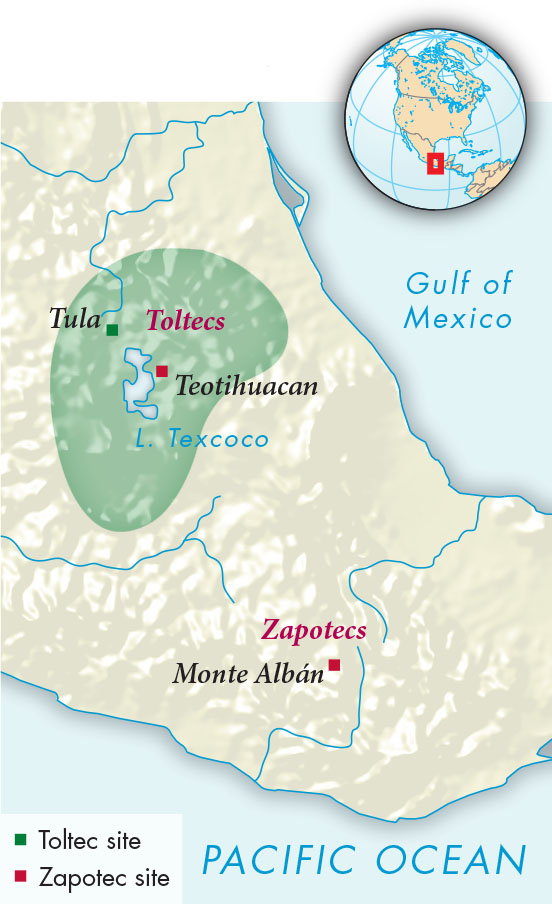A History of World Societies:
Printed Page 313
A History of World Societies Value
Edition: Printed Page 310
Teotihuacan and the Toltecs
The most powerful city in classical Mesoamerica emerged at Teotihuacan, northwest of the lands of the Maya. By 100 C.E. it had a population of 60,000. At its height, between 300 and 600 C.E., its population reached as high as 250,000, making it one of the largest cities in the world at that time. The heart of Teotihuacan was a massive ceremonial center anchored by a colossal Pyramid of the Sun, 700 feet wide and 200 feet tall, and a Pyramid of the Moon. Connecting them was the Avenue of the Dead, 150 feet wide and 2 miles long, along which stood the homes of scores of priests and lords. The monuments of Teotihuacan were so massive that centuries later the Aztecs thought they had been built by giants. A cave under the Pyramid of the Sun suggests the ceremonial center’s origins. Caves symbolized the womb from which the sun and moon were born. It is possible that, like other pilgrimage sites around the world that became important marketplaces, the cave served as both a ceremonial and trade center.3

The monuments of the ceremonial district of Teotihuacan were matched in grandeur by the city’s markets, which extended its influence across Mesoamerica. The city’s trade empire lay in its control of a resource vital to Mesoamerican society and religion: obsidian, a glasslike volcanic rock that could be worked into objects with both material and spiritual uses. Obsidian knives were used for daily tasks and for important rituals such as the blood sacrifice practiced by the Maya. Teotihuacan merchants traded directly with Maya and Zapotec kings, whose local control of obsidian enhanced their power. Teotihuacan’s power was unrivaled in its time, so it was able to extend its influence through trade networks, which included a colony in Kaminaljuyu, near present-
Religion followed trade. Teotihuacan was a religious and cultural center whose influence extended over large distances. One factor in the city’s success was its ethnic diversity. Teotihuacan grew through the migration of outsiders along trade networks, and these groups built separate ethnic neighborhoods. Two gods that were particularly important to classical period civilizations were Tlaloc (Chac in Maya), the god of rain, and Quetzalcoatl, the plumed serpent. The worship of these deities became an enduring aspect of Mesoamerican religion that the Toltecs and the Aztecs embraced. In fact, after their defeat by the Spanish, Aztecs would invoke prophesies of Quetzalcoatl as foretelling the arrival of the Spaniard Hernán Cortés.5
Teotihuacan thrived because it controlled trade of the most valuable goods. This helped it grow, and in turn the trade networks it sustained helped other regions in Mesoamerica develop through intensified contact with other groups and the spread of technologies. Over time, improvements in other regions decreased Teotihuacan’s comparative advantage, as its trading partners produced increasingly valuable goods, spurring competition. By 600 its influence had begun to decline, and in 650 the residents of the city seem to have burned its ceremonial center in what may have been a revolt against the city’s leadership. The city had ceased to be a major trade center by 900 C.E.6

The Toltecs (900–
The Toltec origin myth later merged with the mythology of the Aztecs, who fashioned themselves modern Toltecs, and in turn these myths were adapted in the sixteenth century in order to explain conquest by the Spanish. Through this long and distorted course, the legend went like this: Topiltzin-
The Toltecs built a military empire and gradually absorbed the culture, practices, and religion of their neighbors in the Valley of Mexico. Their empire waned amid war, drought, and famine over the eleventh and twelfth centuries. After the demise of the Toltec Empire, city-